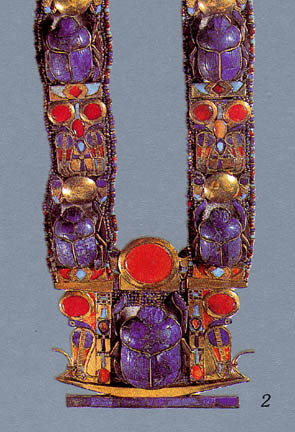 As said before, when delving into a colorful history of any culture, you never know what will be unearthed. This fabulous necklace was found in the tomb of King Tut who reigned in the 18th Dynasty, 1334-1325 BC. The recurring theme in this design is the rising sun-god. The lapis lazuli scarab represents the sun-god, khepri. Scarab beetles lay their eggs which emerge from dung balls, hence the ancient Egyptians thought they came from nowhere. They believe that each day as the sun moved from east to west, the sun itself was pushed like a dung ball by khepri the scarab.
As said before, when delving into a colorful history of any culture, you never know what will be unearthed. This fabulous necklace was found in the tomb of King Tut who reigned in the 18th Dynasty, 1334-1325 BC. The recurring theme in this design is the rising sun-god. The lapis lazuli scarab represents the sun-god, khepri. Scarab beetles lay their eggs which emerge from dung balls, hence the ancient Egyptians thought they came from nowhere. They believe that each day as the sun moved from east to west, the sun itself was pushed like a dung ball by khepri the scarab.
The curved gold shape under the scarab depicts the solar boat which was used for the night journey because khepri was swallowed each evening by the sky goddess. Khepri was reborn each morning. The ancients also believed each night the sun set into the Netherworld. Baboons would then aid the rising sun in its emergence each morning along with bringing up the dead from the Netherworld.
The other semi-precious gem used besides lapis on this necklace is carnelian the bright reddish-orange shapes of the sun. Gold and turquoise are inlaid throughout. This type of grand elegant body decoration was often designed by artisans of the day for the Pharaohs.
Source: Egypt, History and Civilization
